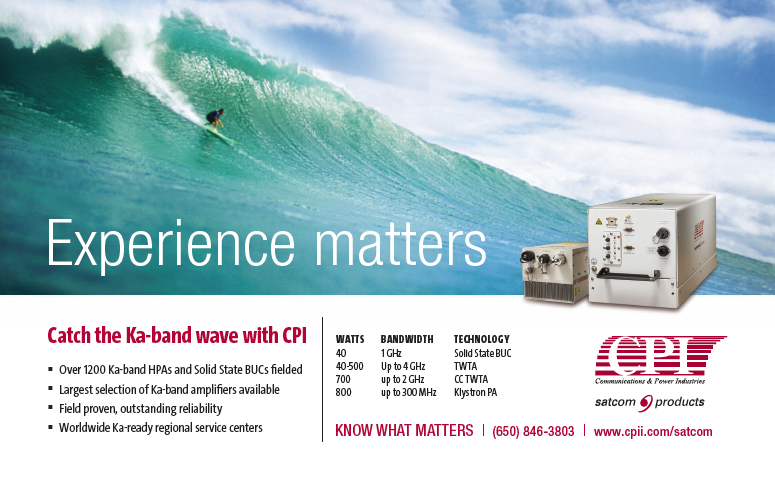Over the past couple of years, IRG has led the push for Carrier ID (CID) to make it far easier to resolve interference when such occurs.

A great deal has happened, with a new CID technology, specifications, a standard, requirements and processes to get CID up and running. However, despite these efforts, and the push from satellite operators to rollout CID, the users are not yet properly on board.
The Stats
The amount of capacity affected by interference at any one moment is quite small, approximately 1 to 2 percent of the total global capacity. There is a certain amount of complacency among users who may not have been affected by interference. However, the impact of interference to any customer can be extremely harmful and everyone needs to be on board to stop such from occurring. For most of the causes of interference, the technology and tools are already in place to drastically reduce the impact. CID is just one more tool in the interference toolbox. However, in the case of CID, IRG asked satellite operator members about the current percentage of CID uptake among their customers—this remains at less than 5 percent. Obviously, the uptake of CID remains low, but we are still at the start of CID rollout.
Knowledge + Understanding
Some of that reticence among users comes down to a simple lack of knowledge and understanding, as well as too many myths that surround the CID technology. Therefore, in order to combat such erroneous beliefs, users must be educated on a number of significant elements.
First, users must be armed with the knowledge that this challenge exists and what the causes of such are, as well as the service impact of satellite interference. Second, users must have an understanding of the various tools available to resolve interference, of which CID is but one. Operators need to be trained, products must be certified, and additional technologies and tools that are aimed at reducing interference must be made known. Users should understand what methods are the most appropriate for their operations and how such should be applied.
There are a number of resources available for users that address this subject, but often users may not be aware of where to look—this must be improved. The basics of CID may be found at IRG’s main website: satirg.org/working-groups/carrier-id// At IRG, a data library is being built that will gather a great deal of that information and other available resources in one location. IRG hopes this database can serve as a resource for operators, manufacturers, and users alike. This library can be a great place to start—simply look up the CID data category or use the built-in search facility.
Equipment
Another barrier remains to interference mitigation, and that is in the realm of equipment. While most manufacturers have now included CID in their products, this process can be costly for users who must replace all of their legacy equipment. The lifecycles on most satellite products are generally lengthy and the challenge is going to be persuading users to replace those products before the natural end of life of that product. One trend that has been most helpful is that the move to S2X—for the most part, all DVB-S2X products have CID. Additionally, the resolutions issued by the World Broadcasting Unions International Media Connectivity Group (WBU-IMCG) mean that all new equipment being purchased for SCPC and MCPC video transmissions must have CID.
This move has been most helpful... unfortunately this doesn’t solve all of the issues. First, just because equipment is CID equipped does not necessarily mean that the user is going to turn CID on. More often that not, satellite products are shipped with CID switched off and must be enabled by the user once that particular piece of equipment has been installed. Second, companies buying equipment for other uses may still be purchasing products that lack CID. Once again, the same difficulty occurs in getting those to change to CID in the months or years to come, especially for those who have recently replaced equipment with non-compliant products. Third, simply having CID integrated doesn’t necessarily ensure the quality of that product. Users need to be encouraged to only purchase certified products, whether that is through the Global VSAT Forum’s (GVF) extensive program or other providers.
Technical Hurdles
Even with the correct equipment installed, users still face technical hurdles when ensuring the proper use of CID. They need to integrate the new equipment into their systems, learn how to use the technology and how to make certain CID is enabled. Even when CID is enabled, ensuring correct transmission is an important concern. Of course, monitoring equipment can detect CID and ensure all is correct.
If you are unsure as whether CID is enabled or not, fitted or turned on, then ask your manufacturer. Once enabled, the equipment will automatically assign your unique identifier—and that’s it. Certainly tell your satellite operator that you have started using or intend to use CID. All major operators have begun integrating CID processes into their networks and many have detection systems in place and are ready to check that the ID is present. That is their part of the bargain. Together with the need to educate users about interference and CID in general, we need to offer the technical knowledge to make it easy for them to get on board with CID.
Overcoming The Hurdles
There remain a number of hurdles that must be overcome to ensure widespread implementation of Carrier ID as well as any subsequent anti-interference technologies. Technology, standards and requirements are an important step and are certainly making a difference to that uptake.
However, if the users don’t have the appropriate knowledge and understanding regarding the problem, how interference can affect them, and the methods to resolve it, only so much can be achieved. Throughout 2016, IRG aims to increase that awareness through education, workshops and events and offer to satellite operators the information they need to ensure their customers are up and running with CID.


